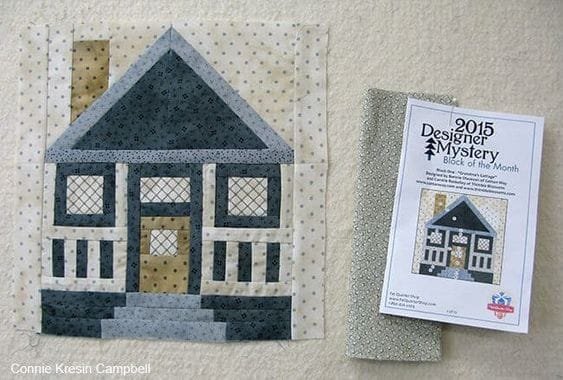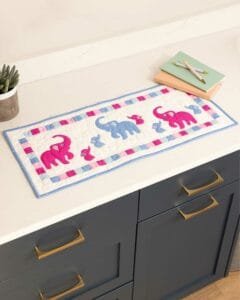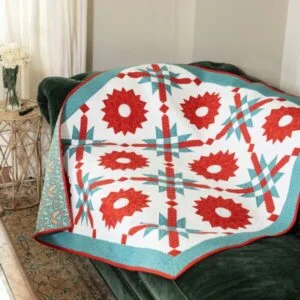Learning to make A Little Housing Block can be a fun and creative project for quilters of all levels. This block pattern, inspired by charming little house designs, allows you to create unique and cozy quilt blocks that can be customized in many ways.
Whether you’re planning a single housing block for a small project or assembling multiple blocks for a full quilt, this tutorial will guide you through each step. With a little patience and attention to detail, you’ll be able to make blocks that are visually appealing and filled with character.
The Little Housing Block is perfect for experimenting with color combinations and fabric patterns, making it an ideal project for using up fabric scraps.

Its design can be made simple for beginners, yet it can also be adapted to more intricate variations for experienced quilters. Additionally, housing blocks are versatile and work well in both traditional and modern quilting styles, so you can personalize them to your taste.
In this tutorial, we’ll cover all the essentials for crafting A Little Housing Block. From choosing the right fabrics and tools to the assembly techniques, you’ll have a step-by-step guide to help you. Let’s get started and make your quilting journey even more rewarding!
1. Selecting the Right Materials and Tools for Your Little Housing Block
Creating A Little Housing Block starts with gathering the proper materials and tools. While quilting doesn’t require many specialized items, having the right supplies will make the process smoother and your finished block look more professional.
Start with high-quality cotton fabric, as it’s ideal for quilting. Choose fabrics in colors and patterns that match your design vision, whether you’re aiming for a rustic look or a vibrant, modern style. Since A Little Housing Block typically includes different sections for the roof, walls, and door, it’s a great chance to mix and match complementary fabrics. Quilters often use leftover scraps to add variety, making it an economical and creative option.
You’ll also need basic quilting tools: a rotary cutter, self-healing cutting mat, quilting ruler, and fabric scissors. These tools are essential for accurately cutting fabric pieces, which is key for fitting the housing block together neatly. Precision is crucial when it comes to quilting, as small discrepancies can affect the alignment of your blocks.
For piecing the block, use a sewing machine with a quarter-inch presser foot, which helps maintain consistent seam allowances. Seam allowances are important because they keep the block’s proportions correct and make it easier to assemble multiple blocks. Additionally, keep a steam iron handy for pressing seams, which gives your blocks a polished finish.
Lastly, it’s helpful to have pins or fabric clips to hold pieces together while you sew. These small tools prevent fabric from shifting, making assembly much easier and more accurate. With all these materials and tools ready, you’re set to start building A Little Housing Block with confidence.
2. Cutting and Preparing Your Fabric Pieces
After gathering your materials, the next step in making A Little Housing Block is to cut and prepare your fabric pieces. Precision in cutting is vital, as it ensures each piece fits perfectly, resulting in a tidy and cohesive block.
Begin by cutting fabric for the block’s different parts. Most housing blocks have distinct sections for the roof, walls, and sometimes windows or doors. For a standard housing block, you’ll need at least three colors: one for the roof, one for the walls, and one for the base. Use your quilting ruler to measure each piece accurately, as this will make it easier to align the pieces during assembly.
Once your fabrics are cut, lay out all the pieces on your work surface in the shape of the block. This layout allows you to visualize how the finished block will look and lets you make adjustments if any pieces don’t align as expected. If needed, trim or adjust pieces at this stage to ensure they fit together smoothly.
Next, press each fabric piece with an iron. Pressing (not ironing) helps set the fabric, making it easier to sew and keeping the pieces from curling or shifting. As you press, ensure your pieces stay true to their measurements; even a slight distortion can affect your finished block.
For more complex blocks, consider marking seam allowances on the back of each piece using a fabric marker. This can be especially helpful for beginners, as it provides a visual guide when you’re sewing the pieces together. If your block includes smaller details like windows, these may require smaller, precisely cut pieces, so take your time to ensure accuracy.
Finally, pin or clip the pieces together to hold them in place before sewing. This simple step will help prevent any shifting and keeps the design elements of A Little Housing Block intact as you sew.
3. Assembling the Housing Block
Once your pieces are prepared, it’s time to assemble A Little Housing Block. This step-by-step process involves sewing the pieces together, ensuring that each section aligns properly to create a cohesive and polished look.
Start with the smaller sections, such as the roof and door if they are separate pieces. Using a quarter-inch seam allowance, sew each section together. For beginners, it can be helpful to sew slowly, checking as you go to ensure everything lines up. Press each seam with an iron before moving on to the next step to keep the fabric flat and seams crisp.
Next, join the roof piece to the walls. This connection is key to making the block look like a house, so make sure it aligns well. Use pins or clips to keep the pieces stable as you sew. After attaching the roof, add the base or other decorative sections if your design includes them. Always press seams as you go, as this makes the block look cleaner and more professional.
Check for accuracy by laying the block on a flat surface. The edges should be even, and the sections should align neatly. If anything looks uneven, you may need to unpick a seam and adjust it. While it might seem tedious, this attention to detail is what makes a beautiful quilt block.
If you’re planning to add more details, such as embroidered windows or doors, now is the time to add those finishing touches. Small embellishments can add charm and personality to A Little Housing Block, giving it a unique look. Keep these details simple so they don’t overpower the block’s overall design.
Lastly, give the entire block a final press. Ironing it flat will help set the seams and give it a professional finish. With the block assembled, you’re ready to move on to joining it with other blocks or finishing it as a stand-alone piece.
4. Joining and Finishing Your Little Housing Blocks
After completing one Little Housing Block, you may decide to make additional blocks to form a larger project. Joining multiple blocks requires attention to alignment and consistency, ensuring that each housing block lines up correctly with its neighbors.
To begin, make sure each block is the same size. Small size differences can make the quilt appear uneven, so trim any excess fabric if needed. Use a ruler and rotary cutter for precise trimming. Consistent sizing also makes it easier to add sashing or borders between blocks if desired.
When you’re ready to join the blocks, place them side by side and check for alignment. Sew the blocks together using a quarter-inch seam allowance, keeping seams straight and consistent. Press each seam as you go, as this helps the blocks lie flat and keeps your quilt top smooth.
Adding a border or sashing between blocks can create a visual separation, enhancing the look of each individual block. Borders also add structure, making the quilt stronger and giving it a polished finish. Choose a border fabric that complements your housing blocks to create a cohesive look.
If you’re turning your blocks into a quilt, you’ll need to add batting and a backing fabric before quilting. This final stage can be as simple or complex as you like, depending on the look you want. Quilting along the seams or adding decorative stitches can enhance the texture and make your quilt unique.
Once quilted, finish by adding binding around the edges. Binding gives your project a completed look and prevents fraying along the edges. After binding, give the quilt a final press to smooth out any wrinkles, and your project is ready to display or gift.
FAQ
Q1: What size should each housing block be?
A1: The block size depends on your project, but a common size for housing blocks is 8×8 inches. Adjust the measurements based on your design needs.
Q2: How much fabric do I need for each block?
A2: Each block typically requires small pieces of fabric, perfect for using up scraps. For a single block, you’ll need around a fat quarter of each main color.
Q3: Can beginners make a Little Housing Block?
A3: Absolutely! A Little Housing Block is beginner-friendly, though precision in cutting and sewing is important. Start with simple blocks, and add details as you gain confidence.
Q4: How can I make my blocks look more realistic?
A4: Experiment with different fabrics and add small details, like embroidered windows or doors. Using contrasting colors for the roof and walls can also add depth.
Q5: Do I need a sewing machine?
A5: A sewing machine is recommended for consistency and speed, especially if you’re making multiple blocks. However, you can hand-sew if you prefer.
Q6: What types of fabric work best for housing blocks?
A6: High-quality cotton fabric is ideal, as it holds its shape well and is easy to work with. Avoid stretchy fabrics, which can distort the block shape.
Join our VIP broadcast list and gain access to exclusive patterns, all for free. As a VIP member, you’ll receive the best patterns daily, delivered directly to your device. ✨📱 It’s a unique opportunity to stay up-to-date with the latest trends and designs, curated just for you. Don’t miss out on enhancing your projects and discovering new inspirations with the best patterns every day! 🎨🔝
Conclusion
In this A Little Housing Block – Tutorial, we’ve covered the essentials of creating a charming quilt block inspired by cozy house designs. By selecting quality materials, following precise cutting and sewing techniques, and adding personal touches, you can craft blocks that reflect your unique style. These blocks are versatile, allowing you to create anything from a small wall hanging to a full quilt.
We hope this tutorial inspires your next quilting project. Let us know your thoughts and share any suggestions to help us make this guide even better! Happy quilting!



